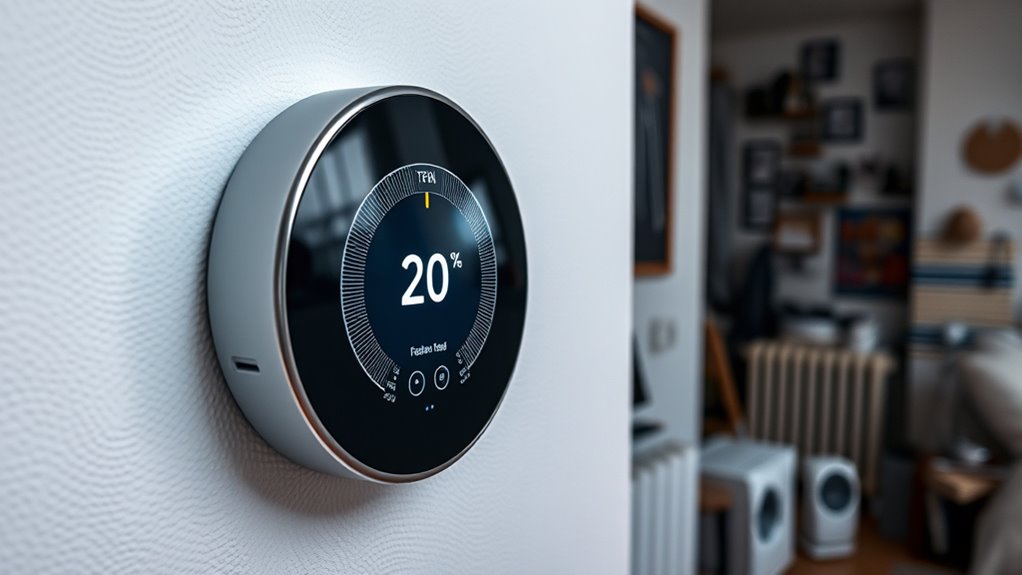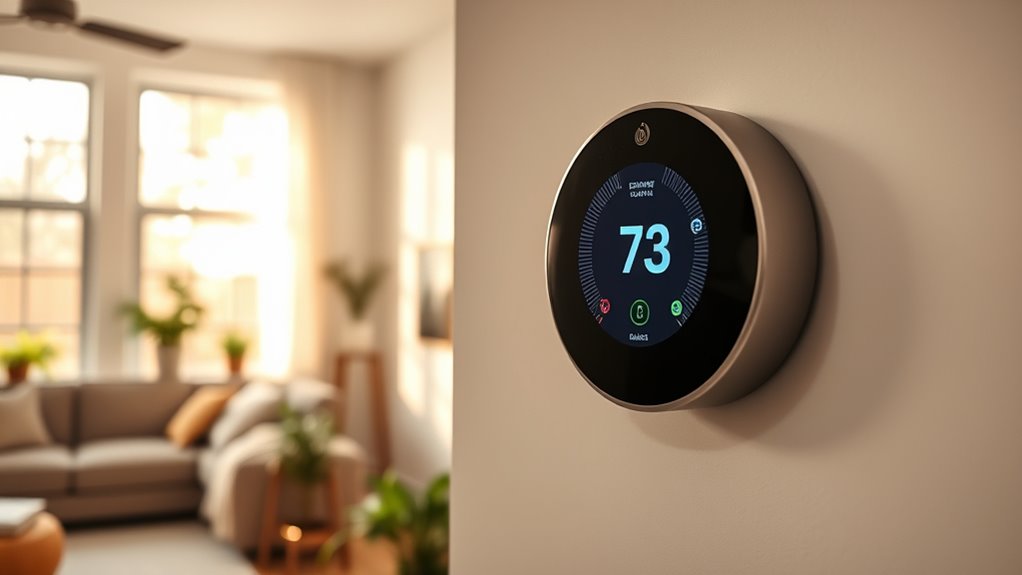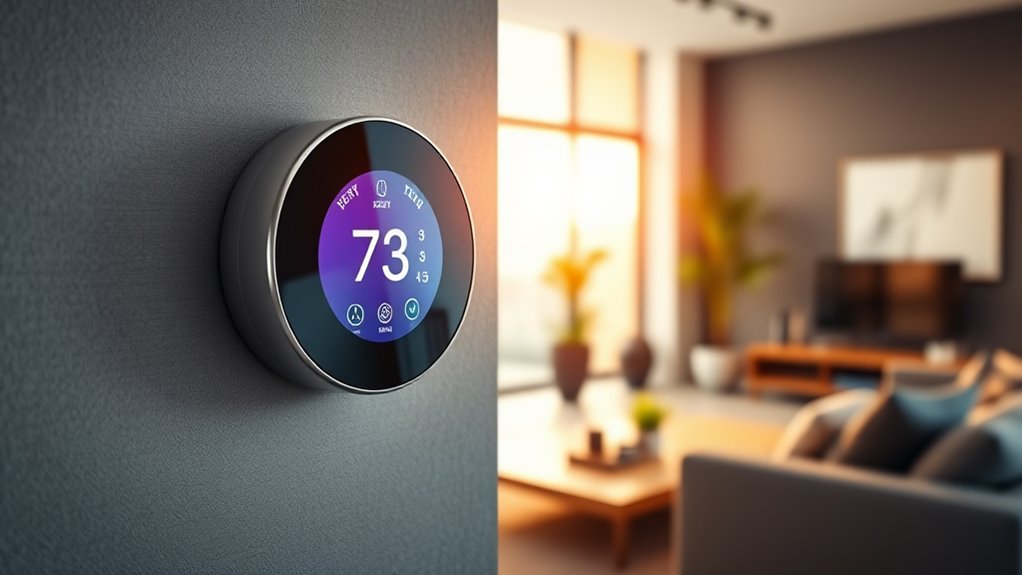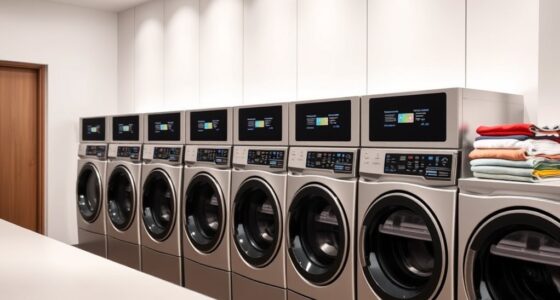Smart thermostats can boost your home comfort and cut energy costs, especially if they’re compatible with your system and properly installed. They learn your preferences, detect occupancy, and let you control your home remotely. However, their savings depend on your existing setup, energy prices, and habits. Not all systems benefit equally, especially radiant heating or constant-use models. Want to discover if one’s right for you? Keep exploring to find out more.
Key Takeaways
- Smart thermostats can save about 8% on energy, translating to roughly $50 annually, making them cost-effective over time.
- Compatibility issues and high installation costs may limit benefits, especially with older or specialized HVAC systems.
- Features like learning algorithms and automation work best with predictable household routines for maximum savings.
- Not ideal for homes with radiant heating or constant occupancy, where automation and savings are minimal.
- Proper setup and understanding system limitations are essential to ensure smart thermostats provide genuine value.
How Smart Thermostats Work and Their Key Features

Smart thermostats work by learning your household’s schedule and preferences through advanced algorithms that automatically adjust temperature settings. They optimize comfort and energy savings by analyzing data from occupancy sensors and geofencing features, which detect when you’re home or away. With Wi-Fi connectivity, you can control these devices remotely via smartphone apps, giving you flexibility and convenience. Many models function as programmable thermostats, allowing you to set schedules directly. They also integrate with other smart home devices, creating a seamless home automation system. Advanced thermostats generate energy reports, helping you track usage patterns and identify savings opportunities. Compatibility with your HVAC system, including heat pumps and multi-stage units, ensures efficient operation, ultimately reducing energy waste and lowering utility bills. Additionally, some smart thermostats can learn from your behavior to enhance energy efficiency, providing even more tailored comfort adjustments. Incorporating home automation features can further streamline your energy management and comfort preferences, making your system more intuitive. Many models also include adaptive learning capabilities that refine their performance over time based on your routine. Moreover, smart thermostats often include user-friendly controls and intuitive interfaces, making setup and daily adjustments straightforward. Furthermore, these devices often include privacy and security features to protect your data and ensure safe operation.
Potential Savings and Benefits for Homeowners

Investing in a smart thermostat can lead to significant savings on your utility bills. With energy savings of around 8%, you could save about $50 annually in low-income multifamily settings, and even more in other climates. Models like Ecobee and Nest can cut heating and cooling costs by 10-15%, thanks to optimized thermostat settings. Features such as occupancy sensors and geo-fencing help improve energy efficiency by adjusting your home climate based on occupancy and location. The remote control capability allows you to fine-tune your system from anywhere, enhancing convenience. Incorporating automation technology into your home setup can further optimize energy use and savings. Additionally, smart thermostats can provide detailed energy usage reports to help you identify further savings opportunities. The typical $420 investment becomes cost-effective within 1-3 years through these savings. Additionally, crochet styles for locs can be incorporated into home decor or personal accessories, offering a creative way to personalize your space. Understanding the regional availability of resources and local laws can further maximize your savings and ensure proper setup. Proper installation and professional guidance can also play a crucial role in achieving optimal performance and safety. Overall, smart thermostats offer homeowners a practical way to reduce expenses while enjoying better control over their home environment.
Factors That Influence Cost-Effectiveness

Several factors can markedly influence whether a smart thermostat is a cost-effective upgrade for your home. Energy savings, averaging around 8%, can improve your return on investment, especially if you live in regions with high energy prices. However, installation expenses, which range from $450 to $1200, can impact overall affordability. Compatibility issues with older or radiant heating systems may limit benefits, reducing potential savings. Features like learning algorithms and remote control are most useful if your household has predictable schedules and already adopts energy-saving practices. The effectiveness of these features depends on your energy costs and existing heating and cooling systems. Additionally, the ability to integrate with other business services can enhance the overall efficiency of your home automation setup. Moreover, understanding home energy management strategies can help maximize the benefits of smart thermostats. Implementing energy-efficient habits can further amplify savings by optimizing your heating and cooling patterns. Conducting a thorough cost-benefit analysis can help you determine if the upfront costs will be offset by long-term savings, making the upgrade worthwhile. Incorporating proper installation practices ensures that your system functions optimally and maximizes energy conservation.
Compatibility and Installation Considerations

Compatibility and installation considerations are essential to guarantee your smart thermostat functions properly and delivers the expected benefits. Before purchasing, check your HVAC system’s compatibility, especially if you have an older setup or unique configurations like radiant heating or heat pumps. Many smart thermostats require a C-wire for power; if your system lacks one, you might need a wiring upgrade or an adapter, which can add to installation costs. Some models are DIY-friendly, allowing easy installation, but others may require professional wiring or technical expertise to ensure proper setup. Always verify system compatibility beforehand to avoid surprises. Proper installation, whether DIY or professional, ensures your smart thermostat works seamlessly and maximizes its energy-saving potential. Additionally, understanding your system’s compatibility requirements can prevent potential issues and ensure optimal performance. Incorporating AI-driven diagnostics can further aid in troubleshooting and maintaining your system effectively. Recognizing the latest innovations in smart thermostat technology can also help you choose the most suitable model for your needs. To further enhance setup success, consulting professional installers can often save time and prevent errors. Being aware of waterproofing considerations is also important if your thermostat will be placed in humid or outdoor environments, ensuring longevity and reliable operation.
When a Smart Thermostat May Not Be the Best Choice

If your home uses radiant heating, a smart thermostat might not deliver the savings you expect. These systems don’t respond quickly to adjustments and often run constantly, making automation less effective. In such cases, installing a smart thermostat may not be worth the investment. Additionally, familiarity with the system can influence how well a smart thermostat performs, especially if the heating setup requires specialized control. Incorporating personal development techniques like mindfulness or goal setting can help homeowners better understand their heating needs and optimize energy use. Given the increasing emphasis on AI Security and safety measures, ensuring your home’s smart devices are secure and trustworthy is also an important consideration.
Existing HVAC System Compatibility
While smart thermostats offer many benefits, they may not be suitable for all HVAC systems, especially older or specialized setups. Legacy HVAC systems often lack the wiring needed for smart thermostat compatibility, such as a C-wire, making installation challenging. Radiant heating systems, like water-based or electric baseboard heaters, typically can’t be controlled effectively by most smart thermostats. Homes with digital controls or wiring issues may face integration problems, especially if the system uses two-wire setups or high voltage systems. These configurations limit the thermostat’s ability to communicate with the HVAC components. If your system isn’t compatible due to wiring limitations or system design, upgrading might be necessary before a smart thermostat can be installed, or it may simply not be a suitable choice.
Minimal Energy Savings
Although smart thermostats are designed to save energy, they may not deliver significant benefits if your home already uses a programmable thermostat with optimized schedules. In such cases, the potential for minimal energy savings is high, and your home’s energy use may not decrease much. If you live in a region with low energy costs or a mild climate, the savings on heating and cooling bills could be negligible. Homes with radiant heating systems or those that operate continuously often won’t benefit much from thermostat setbacks. Additionally, if household occupancy remains constant or the system isn’t regularly adjusted, smart thermostats have limited capacity to save energy. In these situations, investing in smart home devices might not be the best way to save money on energy bills.
Making the Decision: Are They Worth It for You?

Deciding whether a smart thermostat is worth it depends on your home’s HVAC setup and what you want from the device. If your current manual thermostat is outdated, upgrading can improve temperature control, boost home comfort, and offer convenience through automation. Smart thermostats can help you achieve energy savings by optimizing heating and cooling based on household habits, climate, and energy costs. However, if you have a complex or radiant heating system, the benefits might be limited, and the cost may outweigh the savings. Consider how comfortable you are with smart home technology and whether the extra features align with your priorities. Ultimately, evaluating your energy costs, household routines, and home setup will help you decide if a smart thermostat is a worthwhile investment for you.
Frequently Asked Questions
Is There a Downside to Smart Thermostats?
You might find there are a few downsides to smart thermostats. They can be confusing if you prefer simple controls, and compatibility issues with older systems could prevent them from working properly. The upfront costs and installation might not pay off if your energy use is low. Plus, over-reliance on automation can lead to unexpected temperature changes or higher energy bills if not managed carefully.
Is It Worth Installing a Smart Thermostat?
Deciding if it’s worth installing a smart thermostat depends on your home’s energy costs and system compatibility. If you have high utility bills, an HVAC system that supports smart controls, or want remote access, it could be a smart move. While the initial cost is higher, the savings over time, especially with features like learning algorithms, can make it a worthwhile investment for your comfort and budget.
What Happens if Wi-Fi Goes Down With a Smart Thermostat?
Imagine your smart thermostat as a lighthouse guiding your home’s comfort. When Wi-Fi drops, it shifts from a beacon of remote control to a steady, familiar lighthouse on the shoreline. You can still rely on its last settings or local controls, but lost are the real-time updates, weather tweaks, and energy insights. Though the beacon dims temporarily, your home’s warmth remains grounded in the core functions it still provides.
Do Smart Thermostats Lower Electric Bill?
You want to know if smart thermostats lower your electric bill. They can, typically saving you about 8% or more on utility costs by optimizing heating and cooling when you’re not home. Depending on your climate and habits, you might see a 10-12% reduction in heating and 15% in cooling expenses. While savings vary, many users find that a smart thermostat is a worthwhile investment for lower energy bills.
Conclusion
Ultimately, whether a smart thermostat is worth it depends on your home and habits. Think of it as a key that can unlock savings and comfort — but only if it fits your lifestyle. If you’re ready to take control and make your home smarter, it might be a worthwhile investment. Otherwise, weigh the costs carefully. Like a finely tuned engine, the right thermostat can keep your home running smoothly and efficiently.









